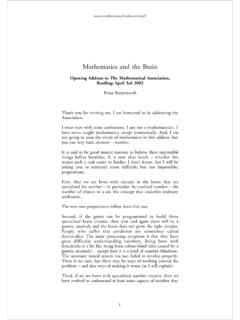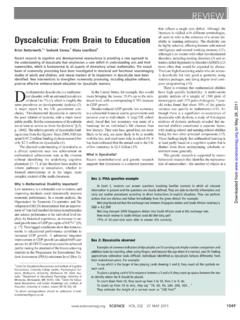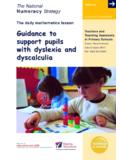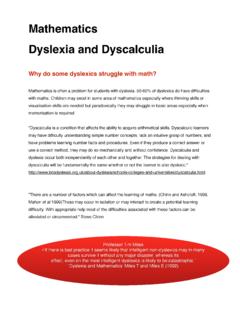Transcription of Developmental dyscalculia and basic numerical …
1 Developmental dyscalculia and basic numericalcapacities: a study of 8 9-year-old studentsKarin Landerla,b, Anna Bevana, Brian Butterwortha,*aInstitute of Cognitive Neuroscience, University College London, 17 Queen Square, London WC1N 3AR, UKbDepartment of Psychology, University of Salzburg, Salzburg, AustriaReceived 21 March 2003; revised 17 September 2003; accepted 13 November 2003 AbstractThirty-one 8- and 9-year-old children selected for dyscalculia , reading difficulties or both, werecompared to controls on a range of basic number processing tasks. Children with dyscalculia onlyhad impaired performance on the tasks despite high-average performance on tests of IQ, vocabularyand working memory tasks.
2 Children with reading disability were mildly impaired only on tasks thatinvolved articulation, while children with both disorders showed a pattern of numerical disabilitysimilar to that of the dyscalculic group, with no special features consequent on their reading orlanguage deficits. We conclude that dyscalculia is the result of specific disabilities in basic numericalprocessing, rather than the consequence of deficits in other cognitive Published by Elsevier : dyscalculia ; numerical processing; Intelligence; Working memory; Arithmetic development1. IntroductionMathematics is a complex subject, involving language, space and quantity. Muchresearch into the development of mathematical skills has focused upon relativelybasic numerical abilities, such as arithmetic or counting (Bisanz, 1999a), but even atsuch early levels many complex abilities are involved.
3 These include transcodingbetween spoken number words and Arabic numerals, relating these to semanticrepresentations of set size ( numerosity ), reasoning about relative set sizes (if 1 isadded to 2, the result should be 3); and understanding the relations between set sizeand counting $ - see front matterq2004 Published by Elsevier 93 (2004) 99 *Corresponding author. Fax: (B. Butterworth).The complexity of numerical processing has made defining what it means to have aspecific mathematical learning disability ( dyscalculia ) difficult. Traditional definitions( DSM-IV,American Psychiatric Association, 1994) state that the child mustsubstantially underachieve on a standardized test relative to the level expected given age,education and intelligence, and must experience disruption to academic achievement ordaily living.
4 Standardized achievement tests, however, generally test a range of skills,which may include spatial and verbal abilities, before collapsing the total into one globalscore of maths achievement . There is thus a substantial risk of Type I errors. In additionstandardized tests are diverse, so what is meant by maths achievement may varysubstantially between tests. For this reason it has been hard for researchers to pinpoint thekey deficits in dyscalculia , or to be sure how to define dyscalculics for range of terms for referring to Developmental maths disability has emerged, alongwith different criteria. Geary and colleagues use the term mathematical disabilities andinclude all children who fall below the 30th percentile (Geary, Hoard, & Hamson, 1999)or35th percentile (Geary, Hoard, & Hamson, 2000)ontheWoodcock JohnsonMathematics reasoning test (Woodcock & Johnson, 2001).
5 Jordan and colleagues(Hanich, Jordan, Kaplan, & Dick, 2001; Jordan, Hanich, & Kaplan, 2003a; Jordan,Kaplan, & Hanich, 2002) refer to mathematics difficulties , and include all childrenbelow the 35th percentile of the Woodcock Johnson Broad Mathematics CompositeScore. The 35th percentile criterion means that the best children will be about SDunits below the mean, and that 90% of the sample will be better than 2 SDs below and Berch (1996)use the term arithmetic learning disabilities and includechildren below the 25th percentile on the Iowa Test of basic Skills. Most children soclassified would fall between and SDs below the expected mean, and could thusbe regarded as in the low average or even the average range.
6 These authors terminology,as well as criteria, make it clear that they are considering a range of causes for lowmathematics achievement, not just the clinical condition of authors refer to dyscalculia or Developmental dyscalculia . They tend to usetheir own tests and a much more stringent , Manor, and Gross-Tsur (1997),who have carried out the most extensive study of this condition, use the criterion of twogrades below chronological age. Butterworth s (2003) dyscalculia Screenerrequires scoreson two tests to be in the lowest two stanines (11th percentile). The study reported here usedteachers report and a criterion of 3 SDs below the mean of the control group to avoid falsepositives.
7 For this group, we will use the term dyscalculia (abbreviated to DC). Features of dyscalculiaThe most generally agreed upon feature of children with dyscalculia is difficulty inlearning and remembering arithmetic facts (Geary, 1993; Geary & Hoard, 2001; Ginsburg,1997; Jordan, Hanich, & Kaplan, 2003b; Jordan & Montani, 1997; Kirby & Becker, 1988;Russell & Ginsburg, 1984; Shalev & Gross-Tsur, 2001). A second feature of children withdyscalculia is difficulty in executing calculation procedures, with immature problem-solving strategies, long solution times and high error rates (Geary, 1993).Temple (1991)has demonstrated using case studies that fact retrieval and proceduraldifficulties are dissociable in dyscalculia .
8 However, case studies, while providingK. Landerl et al. / Cognition 93 (2004) 99 125100important theoretical information on cognitive structures, are not necessarily representa-tive of the majority of dyscalculic children: such dissociations may be ,Yamashita, and Aram (1992)found no dissociation between arithmetic fact ability andprocedural ability in children with numerical processing and Ginsburg(1984)found that a group of children with mathematics difficulties struggled with bothwritten calculation and arithmetic fact (1993)suggests that proceduralproblems are likely to improve with experience, whereas retrieval difficulties are lesslikely to do so.
9 Geary proposes that this dissociation emerges because procedural problemsare due to lack of conceptual understanding, while retrieval difficulties are the result ofgeneral semantic memory dysfunction. However, it is possible that both difficulties resultfrom a lack of conceptual understanding. It may be easier for a child to memorise one ortwo meaningless procedures than the multitude of arithmetic facts (from simple numberbonds to multiplication tables) which, without understanding of cardinality, are simplyunrelated word , then, agree that dyscalculia manifests itself as a problem in learningarithmetic facts and calculation procedures. The question which remains unansweredrelates to the underlying deficits which cause these problems.
10 Various candidates havebeen put forward, including dyslexic difficulties, memory difficulties, spatial difficultiesand attentional difficulties. However, many of the studies which have been designed torelate these underlying abilities to dyscalculia have confounded them with numericalprocessing Underlying processing deficitsOne approach to the study of Developmental dyscalculia involves identifying thecognitive and neuropsychological correlates of dyscalculia in an attempt to extrapolatecausal features or to identify dyscalculia subtypes with differential causes. Suggestedcognitive causes include abnormal representations in semantic memory and difficulty withworking and colleagues (Geary et al.)







